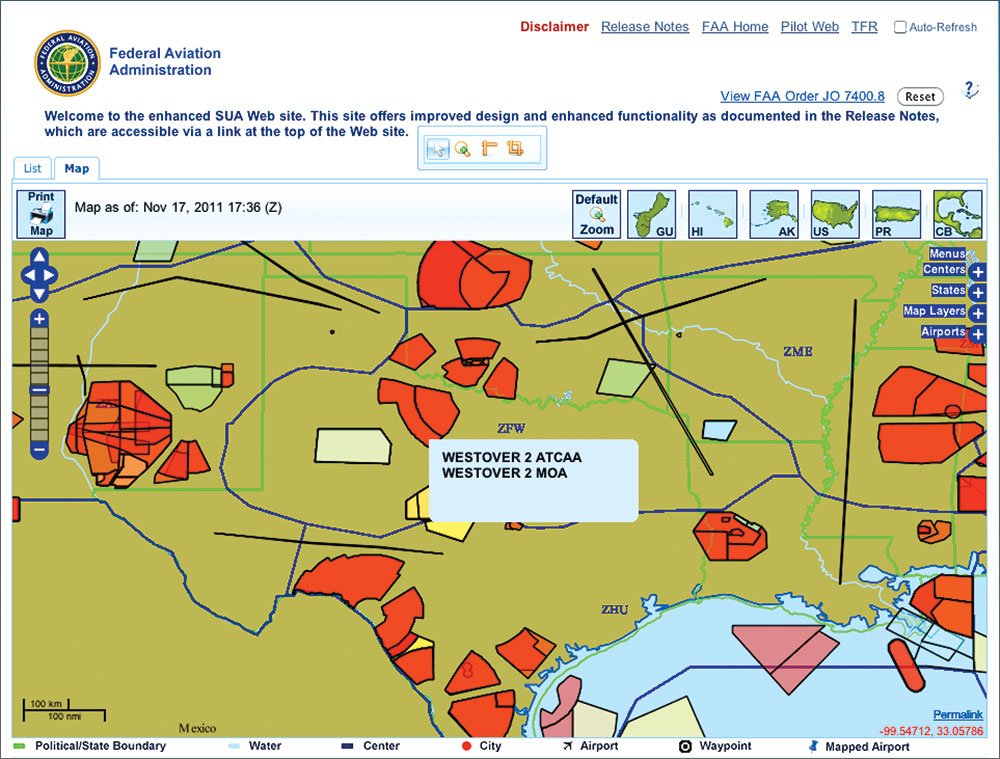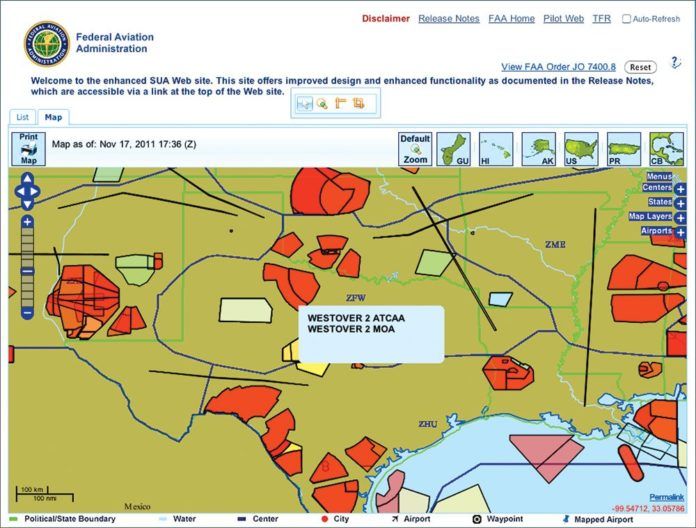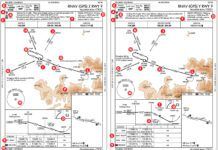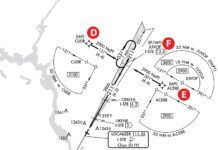Cruising the flight levels, you’re above any of those pesky MOAs. Except some of them have a high-altitude clone that you won’t find on any chart: Behold the ATCAA.

The light jet revolution wasn’t televised because it never happened. At least not yet. There has been a quiet proliferation of small kerosene burners on the ramps and in the flight levels, however, and that means more pilots are experiencing the pleasures and pitfalls of life in Class A airspace.
Upgrading owners who can finally fly GPS direct in their Eclipses may relish the empty white expanses on their new high-altitude en route charts, but just because the chart is empty doesn’t mean the route is clear. And their direct-to reverie may be broken by the instructions from ATC: “Fly heading 030. Vectors around the Westover ATCAA” (pronounced “at-ka”).
Stealth Airspace
You won’t find an ATCAA on any chart. You can find them on the FAA’s special use airspace website (http://sua.faa.gov/). You’ll have to go to the “map layers” settings on the right, however, as ATCAAs are turned off by default. Then you can roll your mouse over any of the areas shown and see the ATCAAs. You’ll notice they often overlie MOAs, which always stop at 18,000 feet. This is a clue where the ATCAAs are and why they exist.
You’ll also find ATCAA in the Pilot-Controller glossary, where it spells out the meaning of the acronym: “ATC ASSIGNED AIRSPACE: Airspace of defined vertical/lateral limits, assigned by ATC, for the purpose of providing air traffic segregation between the specified activities being conducted within the assigned airspace and other IFR air traffic.”
You didn’t think F-16s doing combat practice limited their exploits to 18,000 feet, did you?
Actually, all sorts of military activity can go on in the ATCAA and, when it does, the military basically owns that air. The official wording is that the FAA will give “first priority” or “first consideration” to aircraft operating in the ATCAA. This means it is technically possible for you to be cleared into some ATCAAs while there are aircraft maneuvering in another part of it. It depends on the specific agreement for that ATCAA, the kind of military activity going on, and how far the controller is willing to stick his or her neck out to ensure you don’t mix it up with aerial refueling practice.
The full list of what goes on in these airspaces is extensive. Air-combat maneuvers, air refueling, spins, instrument training, solo student pilot training, radar intercept training, and formation training are just some of the activities. There will never be live fire in the ATCAA; a Restricted Area is required for that, and all potentially affected earth beneath the airspace must be either owned or controlled by the military as well.
Another reason ATC might route you around an active ATCAA rather than work you through is that aircraft on maneuvers might not be on an ATC frequency and might not even be squawking a transponder signal ATC can see. Make that a stealth aircraft as well and, well, radar separation would be difficult to say the least. These activities will make an active ATCAA fully off limits.
ATCAAs usually don’t have fixed vertical boundaries, and even if the aircraft in them are operating high up, you might find an issue getting through down low. Some aircraft operate in the ATCAA on standard baro (29.92) but others may use a local altimeter even though they are venturing into the flight levels.
Imagine military jets are maneuvering in an MOA and ATCAA from 15,000 feet to FL230. They might do so keeping the local altimeter of 30.20. Now you come along at FL200 in a turboprop. ATC could restrict the military aircraft to FL210, but with the different altimeter setting, that 1000 feet of separation would dwindle to 720 feet. If the aircraft come within five miles of each other laterally, the automated snitch would squawk up an operational error for that controller. The fix is to add a buffer and restrict the military to FL220, but if that’s not something the controller can or will do, you’re taking the long way around.
That’s not saying you should plan your trip around these areas. Like an MOA, a cold ATCAA can vanish into procedural non-existence. But if you fly a regular route and find the high-altitude playgrounds keep earning you a re-route, you can find out where they are and perhaps find a preemptive route that avoids the issue altogether.
The MOA’s AtticCruising the flight levels, you’re above any of those pesky MOAs. Except some of them have a high-altitude clone that you won’t find on any chart: Behold the ATCAA.The light jet revolution wasn’t televised because it never happened. At least not yet. There has been a quiet proliferation of small kerosene burners on the ramps and in the flight levels, however, and that means more pilots are experiencing the pleasures and pitfalls of life in Class A airspace.Upgrading owners who can finally fly GPS direct in their Eclipses may relish the empty white expanses on their new high-altitude en route charts, but just because the chart is empty doesn’t mean the route is clear. And their direct-to reverie may be broken by the instructions from ATC: “Fly heading 030. Vectors around the Westover ATCAA” (pronounced “at-ka”).Stealth AirspaceYou won’t find an ATCAA on any chart. You can find them on the FAA’s special use airspace website (http://sua.faa.gov/). You’ll have to go to the “map layers” settings on the right, however, as ATCAAs are turned off by default. Then you can roll your mouse over any of the areas shown and see the ATCAAs. You’ll notice they often overlie MOAs, which always stop at 18,000 feet. This is a clue where the ATCAAs are and why they exist.You’ll also find ATCAA in the Pilot-Controller glossary, where it spells out the meaning of the acronym: “ATC ASSIGNED AIRSPACE: Airspace of defined vertical/lateral limits, assigned by ATC, for the purpose of providing air traffic segregation between the specified activities being conducted within the assigned airspace and other IFR air traffic.”You didn’t think F-16s doing combat practice limited their exploits to 18,000 feet, did you?Actually, all sorts of military activity can go on in the ATCAA and, when it does, the military basically owns that air. The official wording is that the FAA will give “first priority” or “first consideration” to aircraft operating in the ATCAA. This means it is technically possible for you to be cleared into some ATCAAs while there are aircraft maneuvering in another part of it. It depends on the specific agreement for that ATCAA, the kind of military activity going on, and how far the controller is willing to stick his or her neck out to ensure you don’t mix it up with aerial refueling practice.The full list of what goes on in these airspaces is extensive. Air-combat maneuvers, air refueling, spins, instrument training, solo student pilot training, radar intercept training, and formation training are just some of the activities. There will never be live fire in the ATCAA; a Restricted Area is required for that, and all potentially affected earth beneath the airspace must be either owned or controlled by the military as well.Another reason ATC might route you around an active ATCAA rather than work you through is that aircraft on maneuvers might not be on an ATC frequency and might not even be squawking a transponder signal ATC can see. Make that a stealth aircraft as well and, well, radar separation would be difficult to say the least. These activities will make an active ATCAA fully off limits.ATCAAs usually don’t have fixed vertical boundaries, and even if the aircraft in them are operating high up, you might find an issue getting through down low. Some aircraft operate in the ATCAA on standard baro (29.92) but others may use a local altimeter even though they are venturing into the flight levels. Imagine military jets are maneuvering in an MOA and ATCAA from 15,000 feet to FL230. They might do so keeping the local altimeter of 30.20. Now you come along at FL200 in a turboprop. ATC could restrict the military aircraft to FL210, but with the different altimeter setting, that 1000 feet of separation would dwindle to 720 feet. If the aircraft come within five miles of each other laterally, the automated snitch would squawk up an operational error for that controller. The fix is to add a buffer and restrict the military to FL220, but if that’s not something the controller can or will do, you’re taking the long way around.That’s not saying you should plan your trip around these areas. Like an MOA, a cold ATCAA can vanish into procedural non-existence. But if you fly a regular route and find the high-altitude playgrounds keep earning you a re-route, you can find out where they are and perhaps find a preemptive route that avoids the issue altogether.





